Electrical Machines: Unit IV: Single Phase Transformer
All Day Efficiency of a Transformer
Single Phase Transformer
• For a transformer, the efficiency is defined as the ratio of output power to input power. This is its power efficiency. But power efficiency is not the true measure of the performance of some special types of transformers such as distribution transformers.
All Day
Efficiency of a Transformer
AU: May-07, Dec.-09,10,18
•
For a transformer, the efficiency is defined as the ratio of output power to
input power. This is its power efficiency. But power efficiency is not the true
measure of the performance of some special types of transformers such as
distribution transformers.
•
Distribution transformers serve residential and commercial loads. The load on
such transformers vary considerably during the period of the day. For most
period of the day these transformers are working at 30 to 40% of full load only
or even less than that. But the primary of such transformers is energised at
its rated voltage for 24 hours, to provide continuous supply to the consumer.
The core loss which depends on voltage, takes place continuously for all the
loads. But copper loss depends on the load condition. For no load, copper loss
is negligibly small while on full load it is at its rated value. Hence power
efficiency cannot give the measure of true efficiency of such transformers. In
such transformers, the energy output is calculated in kilo watt hours (kWh).
Similarly energy spent in supplying the various losses is also determined in
kilo watt hours (kWh). Then ratio of total energy output to total energy input
(output + losses) is calculated. Such ratio is called Energy efficiency or All
day efficiency of a transformer. Based on this efficiency, the performance of
various distribution transformers is compared. All day efficiency is defined
as,
%
All day η = Output energy in kWh during a day / Input energy in kWh during a
day × 100
=
Output energy in kWh during a day / Output energy + Energy spent for total
losses × 100
•
While calculating energies, all energies can be expressed in watt hour (Wh)
instead of kilo watt hour (kWh).
•
Such distribution transformers are designed to have very low core losses. This
is achieved by limiting the core flux density to lower value by using a
relatively higher core cross-section i.e. larger iron to copper weight ratio. The
maximum efficiency in such transformers occur at about 60-70 % of the full
load. So by proper designing, high energy efficiencies can be achieved for
distribution transformers.
• The calculations of all day efficiency for a
transformer are illustrated in the example 6.20.1.
Ex. 6.20.1
Find the all-day efficiency of a 500 kVA
distribution transformer whose iron loss and full-load copper loss are 1.5 kW
and 6 kW respectively. In a day, it is loaded as follows.
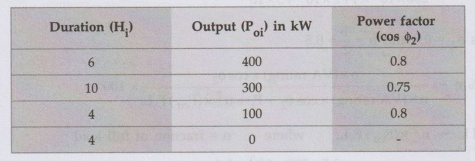
Sol. :
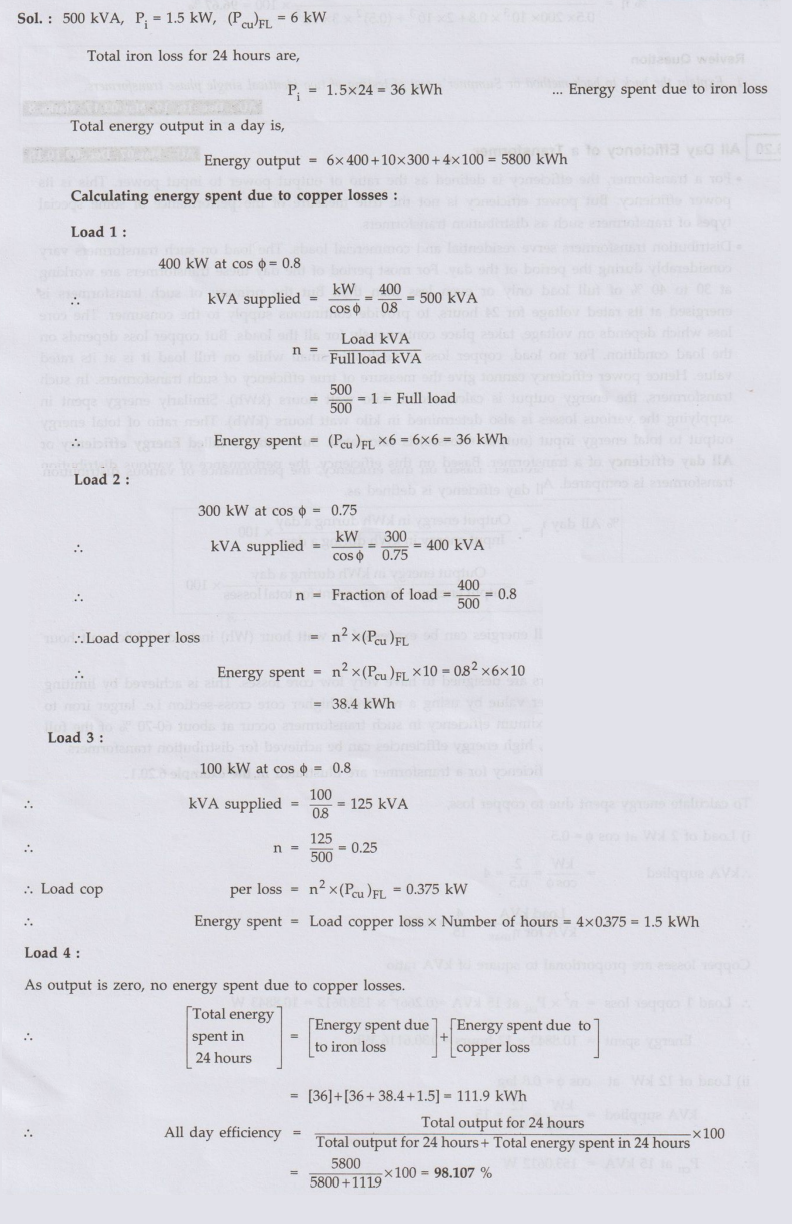
Ex. 6.20.2
A transformer has its maximum efficiency
of 0.98 at 15 kVA, at unity p.f. During the day it is loaded as follows: For 12
hours: 2 kW at 0.5 p.f. lag
For 6 hours: 12 kW at 0.8 p.f. lag
For 6 hours: 18 kW at 0.9 p.f. lag
Find its all day efficiency. AU Dec.-10, Marks 12
Sol. :
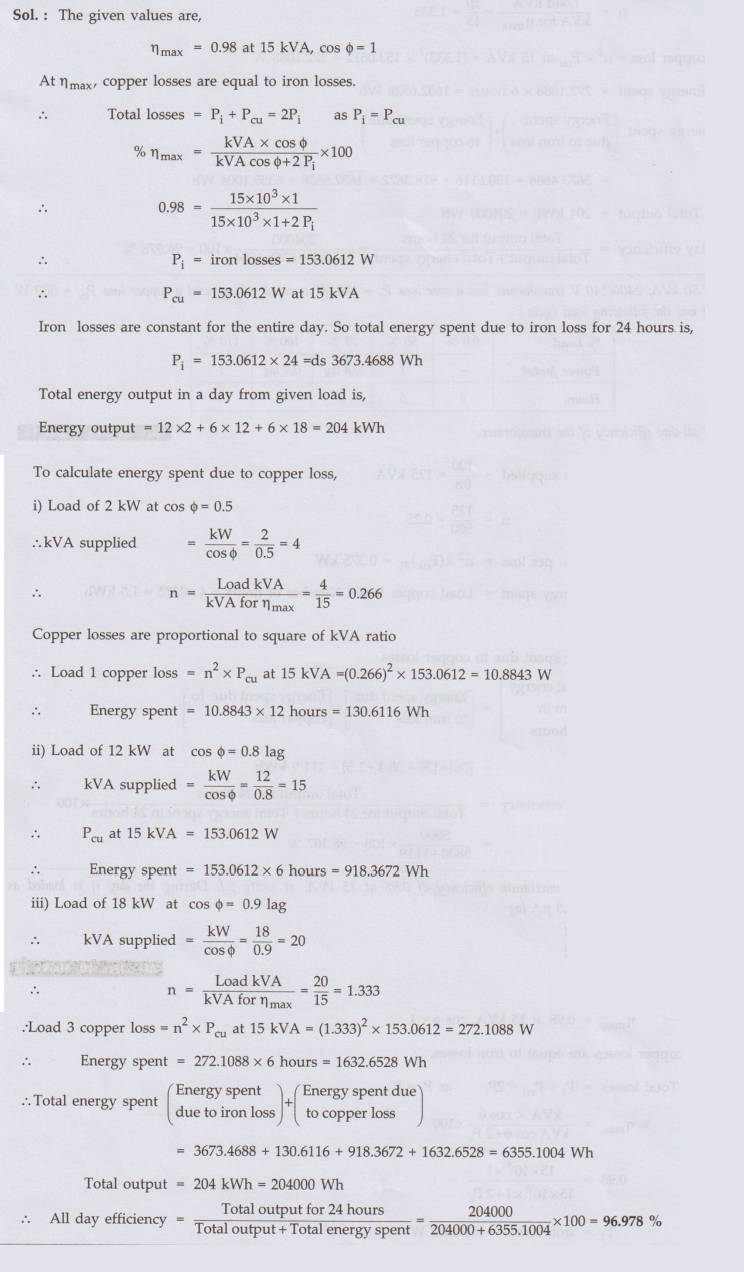
Ex. 6.20.3
A 50 kVA, 2400/240 V transformer has a
core loss Pc = 200 W at rated voltage and a copper loss Pcu
= 500 W at full load. It has the following load cycle:

Determine the all-day efficiency of
the transformer. AU:
Dec.-18, Marks 13
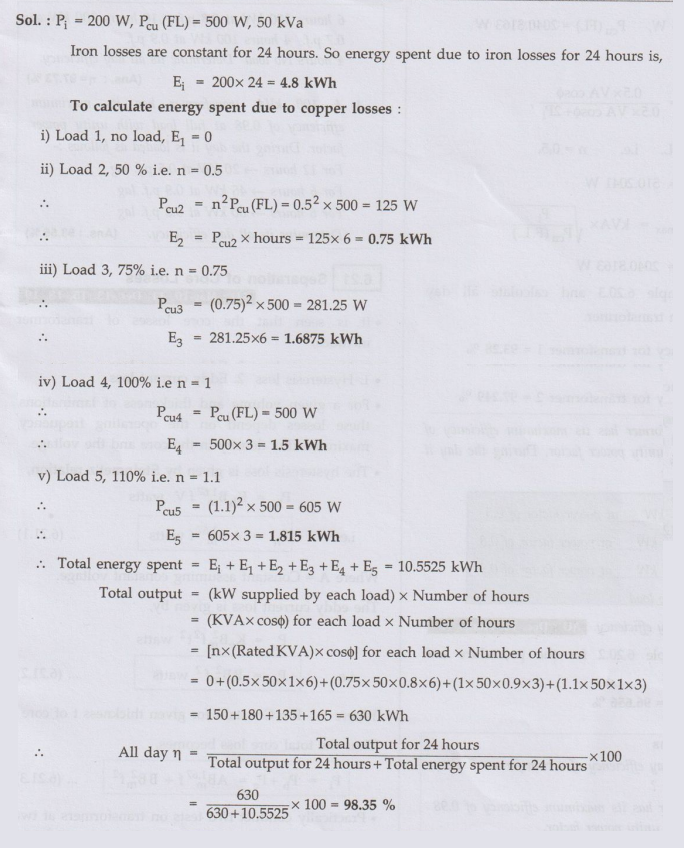
Ex 6.20.4
Two 100 kW transformers each has a
maximum efficiency of 98 % but in one the maximum efficiency occurs at
full-load while in the other, it occurs at half-load. Each transformer is on
full-load for 4 hours, on half-load for 6 hours and on one-tenth load for 14
hours per day. Determine the all-day efficiency of each transformer.
Sol. :
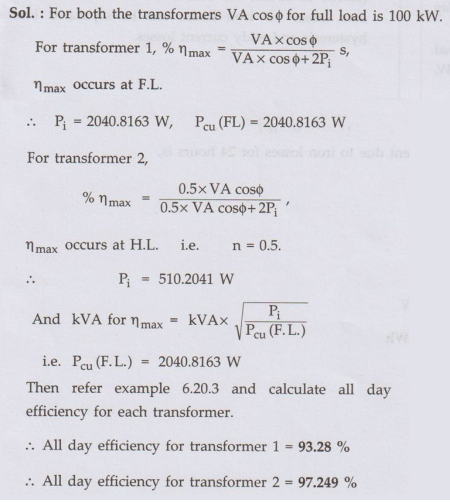
Ex. 6.20.5 A transformer has its maximum
efficiency of 0.98 at 15 kVA at unity power factor. During the day it is loaded
as follows:
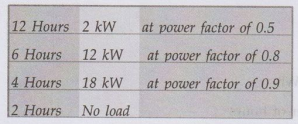
Find the 'All day efficiency.
AU: Dec.-10, Marks 12
Sol. :
Refer
example 6.20.2 for the procedure and verify the answer :
All
day efficiency = 96.656 %
Review Questions
1. What is all day efficiency of a transformer? How to calculate
it?
2. A transformer has its maximum efficiency of 0.98 at 15 kVA at
unity power factor.
During the day it is loaded as follows:
12 hours - 3 kW at 0.5 pF; 6 hours -12 kW at 0.8 pF;
6 hours efficiency.- 18 kW at 0.9 pF. Find its all day
3. A 400 kVA, distribution transformer has full load iron loss
of 2.5 kW and copper loss of 3.5 kW. During a day, its load cycle for 24 hours
is, 6 hours 300 kW at 0.8 p.f. 10 hours 200 kW at 0.7 p.f. 4 hours 100 kW at
0.9 p.f
4 hours No load Determine
its all day efficiency. (Ans.: 97.73 %)
4. A 100 kVA transformer has its maximum efficiency of 0.98 at
full load with unity power factor. During the day it is loaded as follows:-
For 12 hours → 20 kW at
0.5 p.f. lag
For 6 hours→ 45 kW at 0.9 p.f. lag
For 6 hours→ 80 kW at 0.8
p.f. lag
Determine its all day efficiency. (Ans.: 93.55%)
Electrical Machines: Unit IV: Single Phase Transformer : Tag: : Single Phase Transformer - All Day Efficiency of a Transformer
Related Topics
Related Subjects
Electrical Machines I
EE3303 EM 1 3rd Semester EEE Dept | 2021 Regulation | 3rd Semester EEE Dept 2021 Regulation
